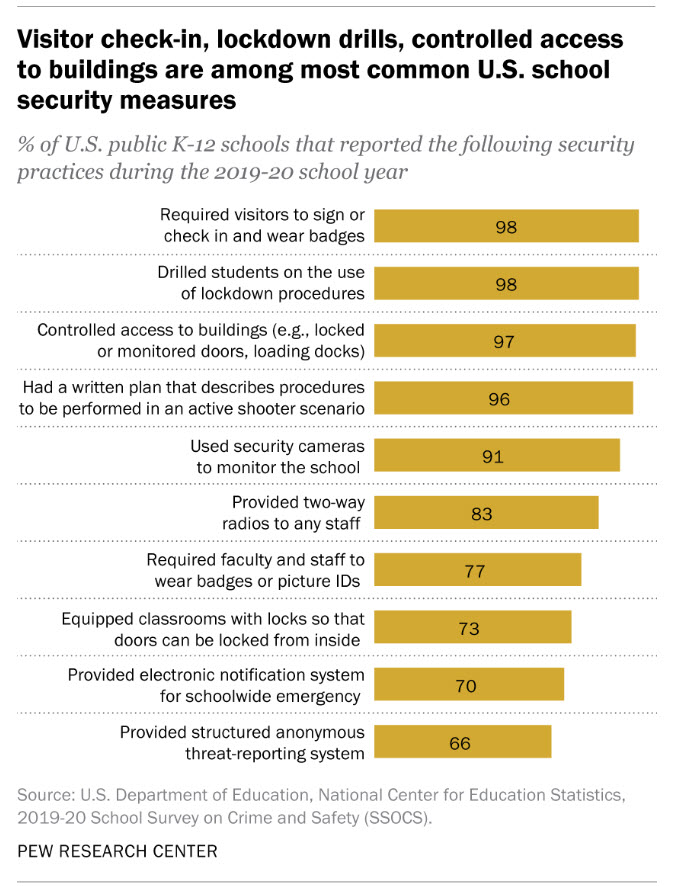Ever wondered how secure our schools really are? Well, you're not alone. The Pew Research Center dove headfirst into this question, surveying 500+ schools across the United States to unravel the mysteries of school safety. What they found might just make you do a double-take.
Imagine this: a quiet morning at Freeman High School in Rockford, Washington, shattered by the echo of security cameras being installed. This wasn't just routine maintenance; it was a direct response to a heart-wrenching tragedy the school faced the year before. This scene perfectly captures the complex dance between determination and the daunting challenges our schools navigate daily to keep students safe. The research into the security protocols of American schools aims to shed light on the evolving school safety landscape.
A Patchwork of Protocols
Recent data from the National Center for Education Statistics (NCES) paints a picture of a nation in action, with nearly all U.S. public K-12 schools—including both traditional and charter institutions—implementing measures to fortify their defenses. From controlling access to buildings with locked or monitored doors (97%) and requiring visitor check-ins (98%), to equipping classrooms with interior locks (73%), schools across the nation are clearly committed to creating safer learning environments.

Source: Pew Research Center
However, the adoption of these measures is not uniform. The disparities become more apparent when considering the socio-economic backdrop of the student population, as represented by eligibility for free or reduced-price lunch. Schools serving higher percentages of students from lower-income households are less likely to have classrooms with locking doors—a discrepancy that underscores the intersection of school safety and equity. Charter schools emerge as slightly more fortified in this aspect, with an 83% likelihood of having doors that lock from the inside, compared to 72% in traditional public schools.
Active Shooter Preparedness: A Rising Standard
The ubiquity of active shooter response plans (96%) and lockdown drills (98%) underscores a sobering reality for U.S. schools. The progression from 79% of schools having written active shooter plans in 2003-04 to nearly all in 2019-20 reflects a societal shift towards heightened vigilance and preparedness.
The Role of Communication and Technology
Security strategies extend beyond physical measures to embrace technology and communication. A significant majority of schools now utilize security cameras (91%) and two-way radios (83%), with seven in ten schools equipped with emergency management system for K-12 schools. The adoption of anonymous reporting system and threat assessment for K-12 schools has seen a remarkable increase, nearly doubling from 36% in 2009-10 to 66% in 2019-20.
Yet, here too, disparities emerge. The prevalence of panic buttons and other security technologies varies by school size, location, and the socioeconomic status of the student body, indicating that school safety measures are not uniformly applied across the board.
Security Personnel: A Growing Presence
The presence of security staff, including armed law enforcement officers, in schools is on the rise, marking a significant shift from a decade ago. Yet, this trend too is nuanced, with larger schools and those serving middle and high school students more likely to have security personnel. The distribution of armed officers also reveals a racial dimension, with schools serving predominantly minority students less likely to have them.
 Source: Pew Research Center
Source: Pew Research Center
Threat Assessment Teams: A Strategic Approach
Approximately two-thirds of schools reported having a threat assessment team, highlighting a strategic approach to identifying and managing potential threats. These teams, more common in urban and suburban settings and at higher education levels, represent a crucial layer in the multifaceted endeavor to safeguard our schools.
The Road Ahead
The Pew Research Center's findings illuminate a landscape of dedication and disparity in school safety measures. As schools grapple with the challenges of protecting students, the data reveals both the strides made and the gaps that remain. This comprehensive look into the safety protocols of American schools not only informs but also invites reflection on the ways we can collectively fortify our schools, ensuring safety of every child.
As we stride ahead, the topic of school safety continues to evolve, driven by a shared commitment to create environments where education and well-being go hand in hand. The journey toward comprehensive school safety is ongoing, with each measure, each strategy, and each conversation contributing to a safer tomorrow for our nation's students.
Kokomo24/7® stands at the forefront of health and safety, offering industry-leading compliance and risk management solutions. Since inception, Kokomo24/7® has built an impressive portfolio, serving both Fortune 1000 companies and notable public-sector clients, including Chicago Public Schools. Curious about our unique experiences? Let's chat about the time we played a key role in hosting the Oscars!
Kokomo24/7® stands as an extended arm to ensure school safety with its comprehensive suite of K-12 software solutions, designed to address the evolving landscape of school safety.

 CASES™
CASES™ ESCALATE™
ESCALATE™ TRIAGE™
TRIAGE™ NOTIFY™
NOTIFY™ FORMS™
FORMS™ ANALYTICS™
ANALYTICS™ HOST™
HOST™ OWLPASS®
OWLPASS® ACCESS™
ACCESS™ WELLNESS™
WELLNESS™ CONNECT™
CONNECT™ CREDENTIALS™
CREDENTIALS™




